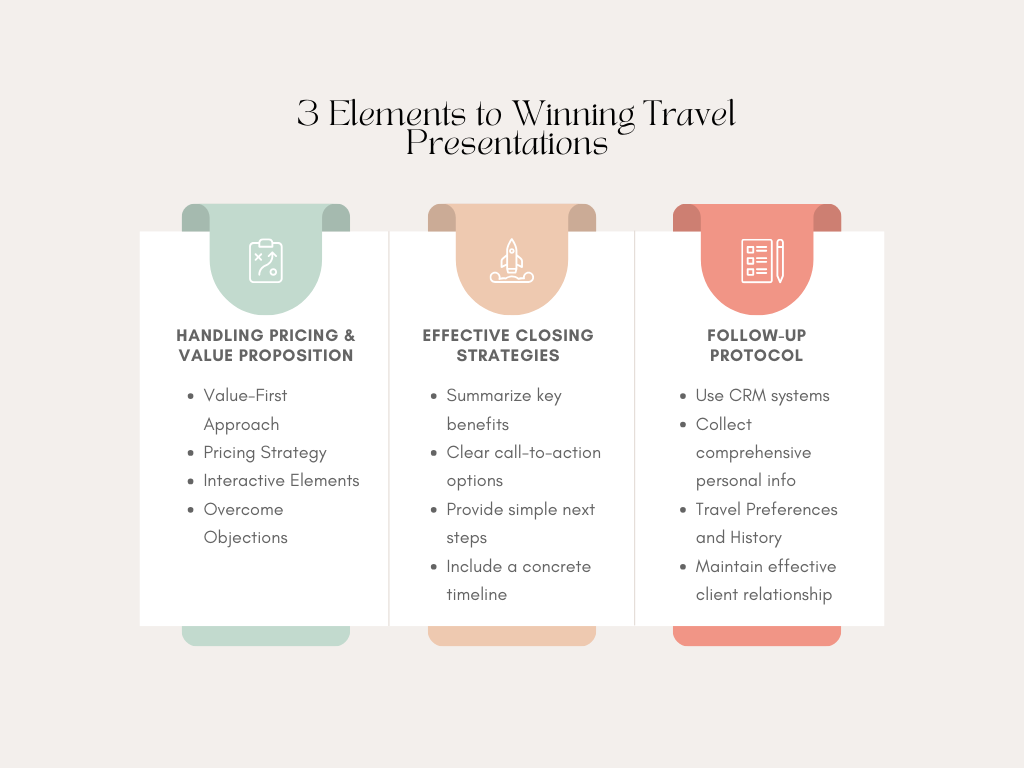The Perfect Pitch: Winning Travel Presentations That Close Sales (Part Three)
From Pitch to Partnership: Turning Presentations into Client Commitments
Written By: Tom Ogg, Co-Founder and Co-Owner – Travel Professional NEWS
Part Three
In parts one and two we looked at how to structure a Winning Travel Presentations and delivery strategies. In part three we look at activities post-presentation that will make new clients out of people in the audience.

Handling Pricing and Value Proposition
One of the most delicate aspects of any Winning Travel Presentations is discussing costs. Position pricing within a broader value context:
Value-First Approach
Begin with the value proposition before revealing prices. What is unique about the travel product that you are presenting? Highlight the exclusive benefits, unique offerings, and inclusions. Demonstrate ROI through concrete examples, such as a client who became ill on a tour but received emergency medical support from the tour escort. Compare total cost of ownership versus competitors.
Pricing Strategy
Present options at different price points. If you are offering different categories in a resort or on a cruise, discuss the benefits and drawbacks of each category. Explain what’s included (and what’s not). Highlight early booking benefits or seasonal advantages and offer flexible payment terms when possible. Be sure to read the Ogg’s book “Selling Group Travel” for detailed information on group costing and pricing.
Interactive Elements
Modern Winning Travel Presentations should encourage engagement and participation, such as including interactive destination maps. Use polls or quick surveys during the presentation. If you can incorporate virtual reality elements when available, it will really get the audience’s attention. Always provide hands-on materials that you can produce.
Common Travel Sales Objections
- Price Concerns: Demonstrate value and ROI. You should have overcome this objection by showing the unique value proposition of your presentation.
- Safety Worries: Detail safety measures. If the travel event will be escorted, share the escort’s qualifications, such as CPR Training, Advanced First Aid Training, Conflict Resolution Training, and Self-Defense Training. Explain all insurance options, letting them know what is included in the pricing.
- Competition Comparisons: Highlight your unique advantages so that other competitors cannot duplicate the travel event being offered.
Effective Closing Strategies
Summarize key benefits and unique value propositions. This is an excellent time to handle questions the audience may have. Present clear call-to-action options by offering any way the clients would want to be contacted. Offer your telephone, email, website, social media, and so on so they can decide the best way for them to follow up. Offer time-sensitive incentives when appropriate. Provide simple next steps for moving forward. It is always best to have a very stimulating deposit if they book at the presentation. Include a concrete timeline for decision-making and never take someone’s word that they are going to book, so you can hold space for them. A deposit holds the space.
Follow-Up Protocol
Your presentation doesn’t end when you leave the room. It is just the beginning of turning presentation participants into future clients.
In today’s competitive travel industry, successful client acquisition requires more than just excellent niche knowledge and booking expertise. Today’s travel agents are increasingly turning to Customer Relationship Management (CRM) systems to systematically grow their client base and provide personalized service at scale.

Essential Client Information for Travel CRM Systems
Basic Personal Information
Travel agents should collect and maintain comprehensive personal details including:
- Full legal name as it appears on travel documents
- Date of birth and nationality
- Passport information including number, expiration date, and issuing country
- Emergency contact information
- Home and billing addresses
- Preferred contact methods and best times to reach
Travel Preferences and History:
- Preferred airlines, hotel chains, and loyalty program memberships
- Seat preferences (window/aisle) and dietary restrictions
- Preferred room types and special accommodation requirements
- Past destinations and trip types (business/leisure)
- Travel budget ranges for different trip categories
- Preferred travel seasons and typical trip duration
- Preferred cruise line, cabin level, rewards status, and so on
Communication and Marketing Data
To maintain effective client relationships:
- Email subscription preferences
- Response history to previous promotional offers
- Preferred communication channels
- Anniversary dates and special occasions
- Social media handles (if clients wish to share)
Benefits of CRM Implementation
Enhanced Customer Service
CRM systems enable travel agents to provide superior service by amassing data that leads to stronger relationships. Based on historical data held in the CRM, an agent can anticipate a client’s needs and wants, tracking client interactions and follow-ups, and schedule future contact with the client. By reviewing the data in a client’s file before making contact, you can make the conversation quite personal. You know everyone’s age, birthdays, names, and so on. When passports need to be renewed, nothing is more impressive than receiving a call from your agent reminding you to renew Winning Travel Presentations.
One of the primary advantages of a CRM is the ability to offer tailored travel suggestions. By storing detailed information about each client’s preferences, such as favorite destinations, budget, and travel history, you can deliver highly personalized recommendations. For example, if a client has expressed interest in a particular destination like the Galapagos Islands, a CRM allows you to monitor deals and contact the client as soon as a great offer becomes available. This proactive approach helps to enhance the customer experience and build stronger relationships.
Revenue Growth
CRM systems contribute to increased revenue by identifying upselling opportunities based on client preferences and targeting promotional offers to interested clients. Also, maintaining regular contact with high-value clients will generate more revenue. An agent can easily manage clients’ loyalty programs and alert them when opportunities appear.
Improving Your Presentation
The best travel sales professionals constantly refine their presentation skills by recording and reviewing their Winning Travel Presentations looking for ways to improve them. Stay updated on industry trends, statistics, and new products. Ask for reviews after a presentation and offer a gift for the review. Regularly update your presentation materials.

The Art & Science of Travel Presentations: From Vision to Victory
Creating winning travel presentations is both an art and a science. Success requires careful preparation, authentic delivery, and consistent follow-through. By understanding your audience, crafting compelling visuals, addressing objections proactively, and maintaining professional follow-up, you can significantly improve your closing rates and build a strong client base.
The most successful Winning Travel Presentations aren’t just about selling a destination or service – they’re about creating a vision of possibility that resonates with your prospects’ desires and needs. When you combine thorough preparation with passionate delivery and professional follow-through, you create presentations that not only close sales but also build lasting client relationships.
Remember that each presentation is an opportunity to refine your approach and learn from your audience’s responses. Stay flexible, remain authentic, and always focus on the value you can bring to your clients’ travel experiences. With these elements in place, your Winning Travel Presentations will become powerful tools for growing your business and exceeding your sales goals.



